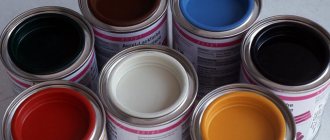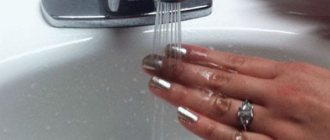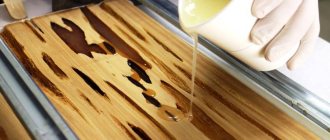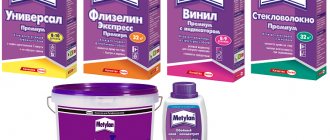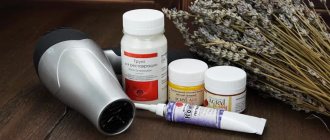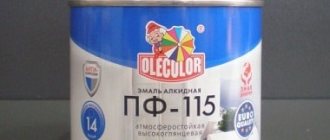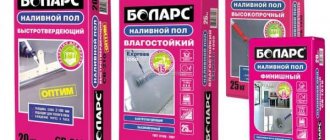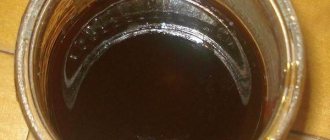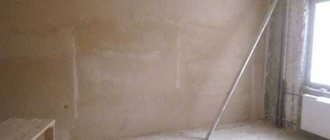Construction and repair work is a complex technological process that involves basic and decorative stages. For this purpose, various materials are used to make the house beautiful both inside and outside. Wooden flooring has always been considered one of the best options. Floors, walls, and frame products retain their qualities well for many years and do not lose their pleasant appearance. However, in order for surfaces to last as long as possible, they must be properly treated. In such cases, drying oil for wood is ideal.
Paint consumption per square meter, per 1m2
This article provides information on paint consumption per square meter, as well as the conditions on which paint consumption depends.
We will touch on types of paint, such as: oil-based, water-dispersion and water-based, facade. We’ll also talk about the consumption of enamels, in particular about PF-115. Let's analyze the consumption of drying oil. Try calculating your consumption in the extended version of the paint consumption calculator, you can also read the article about the consumption of plaster materials and calculate the consumption of plaster for walls in the calculator.
Oil paint consumption
Oil paints use drying oil as a binder, which polymerizes after application to the surface. Consumption can vary from 140 grams per meter to 250. Let's look at it in more detail: For a flat surface, we will need about 150 grams per meter, that is, with a kilogram can we can paint about 6.5 meters. For a rough surface, more will be required, approximately 160 g/m. Colored paint per 1m2 will require 130-140 grams.
Consumption of enamel pf-115
Consumption of acrylic-based water-dispersion paint
Acrylic-based water-dispersion paints are used both indoors and when working on facades. They have a matte appearance and are tinted with color pastes. They provide a large palette of colors that do not fade in the sun. The manufacturer indicates consumption up to 8 m2 per 1 liter, but in practice the covering capacity is usually 115 g/m2 (i.e. 1 liter per 6-7 m2). The fact is that the manufacturer indicates the given consumption rates in a thin layer, on a smooth surface, under ideal conditions. In practice, much depends on the absorbency and surface roughness. The method of application also matters. For example, when using a spray gun, less paint will be used than when working with a roller. Again, a roller is more economical than a brush. Be aware that you will need 5-15% more paint than indicated on the package. Apply acrylic paints in 2-3 layers on a clean, dry base. Moreover, a high-quality composition will cover the color of the base in 2 layers, while a cheaper version will require 3 layers. Thus, cheap paint can actually cost more.
The color can last on concrete without visible changes for up to 5 years, then it darkens and after 2-3 years it can begin to peel off. If such paint is applied to plaster, cement, etc. , then priming can be done with it, diluted with water up to 10%. Then a layer of undiluted paint is applied.
Consumption of water-based paint
Water-based paints are used for finishing ceilings and any other surfaces, except those that were previously painted with glossy paint. When calculating paint consumption, you need to focus on the consumption per square meter specified by the manufacturer. On average it is 1 liter per 7-11 m2. For some water-based paints, one liter is enough for 14-18 m2 in one layer. But the indicated consumption may not coincide with the actual one; the absorbency of the surface should be taken into account. To reduce paint consumption and increase service life, it is recommended to treat the surface with a hardening primer. Do not apply water-based paint in a thick layer. Most often, 2-3 layers are made, each subsequent one is applied after the previous one has dried, after 1.5-2 hours. Paints based on butadiene styrene are highly resistant to moisture, but may turn yellow when exposed to light.
Facade paint consumption per 1m2
Almost all types of paints can be used as façade paint, so it is concluded that a specific type has its own consumption. Approximate consumption values are from 160 to 250 grams per square meter, while the consumption of white paint is always greater than other colors. Painting the facade will protect it well and preserve it, so the work should be done carefully and not try to save money.
Drying oil consumption per 1m2
Drying oil consumption ranges from 100 to 130 grams per square meter. By pre-coating a wooden surface with drying oil, you can save paint by 10-15%
The concept of “paint hiding power”
The greater the hiding power, the better the new paint covers the color of the old one, thus, the better the hiding power, the more economical the use. The best indicator is 20-40 g/1m2 of surface.
How to coat plywood with drying oil on both sides? What are the nuances?
How to coat plywood with drying oil on both sides at once?
What will be the consumption of drying oil per 1 m2 of plywood? Is 1 coat enough coverage? Typically, plywood is impregnated with drying oil if there is a need to increase the moisture resistance of the material.
Of course, you can saturate the plywood on both sides; it won’t make things worse, but you have to be prepared for the fact that it will take days, and possibly weeks, to completely dry.
To coat at one time, the plywood must be in a vertical position so that it is possible to turn the sheet over, in other words, lean the plywood against the wall and thus work with the sheet.
Plywood is different in grade, thickness and texture, which is why the consumption of drying oil is different, on average, from 80 to 100 grams of drying oil are used per square meter.
One layer is not enough, perhaps three layers will not be enough, the reason was described above (texture, grade, thickness), the plywood is impregnated with drying oil until it is saturated to the adhesive layer.
For this purpose, buy natural drying oil, you can dilute it a little with white spirit,
but better than natural and without solvent.
Before applying drying oil to the surface of plywood, it (the drying oil) is heated in a water bath, the drying oil should be hot, but do not “overdo it” with the temperature, hot is closer to warm, that’s right.
Next, clean the plywood from dust and dirt.
Using a brush or roller, apply drying oil to both sides of the plywood, do not forget about the ends.
After this, we dry the plywood with an industrial hair dryer.
Next is a new layer of drying oil and so on until the plywood stops “accepting” drying oil, in other words, the absorption process stops.
More questions on your topic:
- What is the essence of the technology of coating plywood with drying oil?
- How can you remove drying oil from plywood?
- How to wash off drying oil from plywood?
- How to accurately calculate paint consumption per 1 m2 in two layers?
- What are the advantages of the Solex carburetor? Is it worth installing a carburetor?
- How to calculate how many sq. m. m. ceramics. tiles or plastic panels?
- How much water-based paint is consumed per 100 square meters?
- Consumption standards for building materials, where can I look?
- What is the consumption of cement and sand per 1 cubic meter? stone plinth (rubble)?
- How to get rid of drying oil smell on a wooden door?
Drying oil: what is it, composition and properties
In any repair and finishing work, as a rule, a lot of wood materials are used. To effectively protect wood from the destructive effects of moisture, fungi and mold, it is impregnated with a layer of drying oil.
Peculiarities
During the Soviet era, drying oil was practically the only means that was used for processing wooden buildings and individual products. Now the materials market is much higher, the industry offers a large selection of more modern and practical coatings. However, admirers of drying oil exist to this day.
The use of drying oil can significantly increase the durability of wooden structures , which is especially important for rafters, since they are highly susceptible to water and condensation.
In addition, impregnation with this composition effectively protects the coating from temperature fluctuations, high humidity and destructive atmospheric influences of all types.
When wood is treated with drying oil, a film is formed on it, which is hard, but at the same time plastic. It is this that protects the material from external adverse influences, as well as from the appearance of mold and fungal growth. It is drying oil that will prevent the wood from rotting, and in addition, its use significantly minimizes the consumption of enamels and paint , which can be used as a finishing material. As a rule, drying oil is applied in 2-3 layers, and then only painted with paints.
Another undoubted advantage of the solution is its low price and availability. Basically, drying oil is used for interior finishing work , but use in an open space causes only a temporary effect, which requires mandatory painting or varnishing in the future.
Specifications
The mechanism of action of drying oil is based on the physical properties of its constituent components.
If vegetable oil is applied to any surface and left in the fresh air, then under the influence of heat, sunlight and oxygen it begins to thicken. If the oil is applied in a thin layer, it dries and forms a semi-solid composition . This quality is characteristic of such oils, the main components of which are linolenic and linoleic acids. Moreover, the higher the concentration of these acids, the more pronounced they exhibit the property of hardening.
The content of these components usually varies in different types of oils. For example, in flaxseed oil their share is 80%, in hemp oil - 70%, but in sunflower and nut oil their content is less - from 30 to 45%, and in olive oil the acids are 40%.
Mineral-based oils do not contain fatty acids at all, which is why they do not dry out in the air.
However, in their natural form without heat treatment, vegetable oils oxidize quite rarely, even if they contain fatty acids in significant quantities. That is why, in order to stabilize the wood and shorten the drying period, the composition is processed and driers are introduced into it - various metal salts, which significantly reduce the drying time of the oil. Thanks to this composition, drying oil can dry from 6 to 36 hours after application, but, as a rule, modern products harden within a day.
The shelf life of any type of drying oil is at least 3 years.
What it is?
Wood is once again returning to the list of leaders in consumer preferences, while plastics and other synthetic materials are losing demand. But it is important to understand that wood needs professional, high-quality processing, and drying oil allows you to cover the wooden base with a protective film, while ensuring a high level of sanitary safety. The main part of such compositions is formed by natural components (vegetable oils), and they account for at least 45% of the mass.
Drying oil consumption per 1m2 for wood
Construction and repair work is a complex technological process that involves basic and decorative stages. For this purpose, various materials are used to make the house beautiful both inside and outside. Wooden flooring has always been considered one of the best options. Floors, walls, and frame products retain their qualities well for many years and do not lose their pleasant appearance. However, in order for surfaces to last as long as possible, they must be properly treated. In such cases, drying oil for wood is ideal.
Features of the composition and use of drying oil for wood
This product is widely used by experienced craftsmen when working with natural materials. The basis of the mixture is made up of vegetable oils, which are subjected to special heat treatment. As a result of chemical changes, the solution forms a film when applied, which performs a protective function. On sale you can find solutions of various colors from light yellow to dark brown with a cherry tint. This diversity is due to the characteristics of each mixture.
Vegetable oils harden very slowly. Therefore, during the production process additional components are added to them. Thus, the suspension is represented by the following main substances:
- natural oils - sunflower, flaxseed, hemp, soybean, rapeseed;
- driers - elements of metals such as cobalt, iron, manganese, lead.
After being applied to wood, drying oil gradually polymerizes, turning into a film of elastic structure. The drying time of the solution depends on the type of oil, active metal compounds, as well as their percentage. The higher the amount of synthetic adjuvants in the composition, the faster the drying oil hardens.
Experts recommend opening the wood with an oil-based solution. This allows us to solve the following problems.
- Ensure the protection of natural materials from the effects of negative environmental factors.
- Reduce the consumption of paint and varnish mixtures in subsequent stages of repair.
- Increase the service life of coatings.
- Prevent the development of mold and mildew on wood products.
- It is good to saturate the natural material to lighten the wood.
- Improve the external quality of walls, floors and other functional products.
The mixture can be used to dilute putties, which significantly saves the budget and allows you to replace it with a mixture with drying oil. They also produce oil paint based on natural drying oil.
The consumption of drying oil for wood depends on several factors. If a specialist is involved in the repair, he will quickly determine the amount of substance that will be needed for processing. However, you can calculate the volume of the solution yourself. For this, the following conditions are taken into account:
- wood covering area;
- where the work will be carried out - indoors or outdoors;
- atmospheric parameters - humidity, air temperature;
- type and quality of the base material.
Consumption per 1 m2
Before purchasing, it is better to read the instructions that accompany each mixture option.
Important! It is necessary to pay attention to the composition of the product and the rules for its use.
The calculation is made on 1m2. The average consumption of drying oil on the surface is from 100 to 250 grams. The average volume is 120 - 130 grams. In most cases, you need to remember that treatment with drying oil is carried out several times with repeated application of the layer. Therefore, consumption may increase.
How to do it yourself?
In the absence of factory products, quite high-quality drying oil is often made at home from sunflower oil. To obtain a product based on flaxseed oil, you will need to heat it slowly, until the water evaporates, but without warming it above 160 degrees. The cooking time is 4 hours; it is not advisable to cook a large amount of oil at the same time. Filling the vessel halfway provides increased fire protection and significant productivity.
When foam appears, you can introduce the drier in small portions - only 0.03 - 0.04 kg per 1 liter of oil. The subsequent cooking time at 200 degrees reaches 180 minutes. The readiness of the solution is assessed by the complete transparency of a drop of the mixture placed on a clean thin glass. The drying oil should be cooled slowly at room temperature. Drying agent is also sometimes made with your own hands: 20 parts of rosin are combined with 1 part of manganese peroxide, and the rosin is first heated to 150 degrees.
To learn how to use drying oil correctly, watch the following video.
Popular posts
- Chair for dressing table Chairs for dressing tables in Moscow - 189 Products Company from Moscow, delivery 29643 a In…
- Silicone sanitary sealant Silicone sanitary sealant white in Moscow - 1491 products Company from Moscow, delivery (tomorrow) 140...
- Shelf in the hallway Currently, there are a huge number of different options for shelves in the hallway, and this is directly ...
- Insulation of the floor in a wooden Insulation of the floor in a wooden house from below: materials and installation technology SHARE ON SOCIAL NETWORKS One of the common…
Types of drying oil for wooden surfaces
Manufacturers produce various types of mixtures for woodworking. They differ not only in quality characteristics and properties, but also in price. Some drying oils are suitable only for indoor work, others are universal means for basic repairs. Drying oils are represented by the following types:
- natural;
- oxols;
- combined;
- synthetic.
Natural compositions
The natural mixture is obtained by exposure to high temperatures for 12 hours followed by oxidation. As a result, the output is a viscous liquid with a characteristic odor of plant material. Depending on the type of oil, the color may be dark brown or a lighter shade. High-grade drying oil is made from flax. However, it is the most expensive.
Natural compositions are a good impregnation of wood, creating a film on the surface, and serve to lighten. They are non-toxic and therefore recommended for use inside residential buildings. The only drawback is the long drying period, especially in high humidity. On average, drying oil for wood takes 24 hours to dry.
Semi-natural compounds - oxols
The semi-natural composition contains a mixture of oils that make up about 60 percent. The remaining components are driers in combination with petroleum polymer resins, turpentine or white spirit. The advantage of oxol is its fast hardening time. When applying drying oil, a durable elastic layer is formed. This solution option is an affordable means for treating wood, given the low price. Oxol has an unpleasant odor that persists for a long period of time.
Combined formulations
Many people are interested in why a combination mixture is needed. It can be applied to wood surfaces both indoors and for outdoor use. The solution contains 7 parts natural oil and 3 parts solvent, which allows the product to dry quickly. Two types of mixture are produced.
- K-2 - used for processing wooden surfaces. It has virtually no odor, so it can be used for decorative finishing in rooms. It has a beautiful fawn shade.
- K-3 - cover facades, pillars and frame structures on the streets. The product is resistant to atmospheric factors.
Synthetic compounds
The scope of application of synthetic drying oil is exclusively for outdoor use. The mixture is rarely used for wood; more often it is used to cover metal or wooden structures in non-residential premises. The solution has a sharp, unpleasant odor that lasts for a long time and may not completely
weathered. Considering the toxic effect of petroleum products, it is not used inside homes. The suspension contains only 20% natural oil, the rest consists of components from diesel shale oil, shale gasoline and solvent. The main advantage is low cost.
SAFETY REQUIREMENTS
3.1. Drying oil oxol is a toxic and flammable liquid, dangerous at elevated temperatures, which is due to the properties of the solvents and oils included in its composition. The toxicity and fire hazard characteristics of the solvents included in drying oil oxol are given in Table 2.
table 2
| Solvent name | Maximum permissible concentration in the air of the working area of industrial premises, mg/m | Temperature, °C | Concentration limits of ignition,%, by volume | Hazard Class |
| self-ignition | upper | |||
| White spirit (nefras S-155/200) (GOST 3134) | ||||
| Nefras S-150/200 | ||||
| Turpentine (GOST 1571) |
The fire and explosion hazard indicators of drying oil oxol are given in Table 3.
Table 3
| Product name | Self-ignition temperature, °C | Flash point in a closed crucible, °C | Temperature in an open crucible, °C | Temperature limits of ignition, °C |
| flashes | ignition | |||
| Drying oil oxol (solvent - white spirit (nefras S-155/200)) | ||||
| Drying oil oxol (solvent - nefras S-150/200) |
(Changed edition, Amendment No. 1, 2).
3.2. During the production, testing and use of oxol drying oil, fire safety requirements in accordance with GOST 12.1.004 and GOST 12.3.005 must be observed, the premises must be equipped with fire fighting equipment in accordance with GOST 12.4.009.
3.2.1. Work on opening metal packaging must be carried out with tools that do not produce a spark upon impact.
3.2.2. In case of fire, use all fire extinguishing means (chemical foam, water vapor, finely sprayed water, inert gas, asbestos sheet).
3.3. In the premises for storing and using oxol drying oil, the presence of open fire is prohibited; artificial lighting and electrical equipment must be explosion-proof.
3.4. Personal protective equipment - according to GOST 12.4.011.
3.2-3.4. (Changed edition, Amendment No. 1).
3.5. All work related to the manufacture, testing, use and storage of oxol drying oil must be carried out in rooms equipped with supply and exhaust ventilation or well ventilated. (Introduced additionally, Amendment No. 2). (Changed edition, Amendment No. 1, 2) .
5.4. Determination of acid number - according to GOST 5476. For dissolution, use a mixture of one part of ethyl alcohol and two parts of ethyl ether or a mixture of equal volumes of ethyl alcohol and benzene according to GOST 5955, or a mixture of equal volumes of ethyl alcohol or toluene according to GOST 5789.
5.5. Determination of the mass fraction of non-volatile substances - according to GOST 17537, section 1. In this case, 1.5-2.0 g of drying oil is placed in a cup, weighed and the result is recorded to the second decimal place. The contents of the cup are distributed by rotation into a thin layer along the bottom of the cup. Then the cup is placed in a drying cabinet and dried for 15 minutes at a temperature of (140 ± 2) ° C, after which the cup is cooled in a desiccator, weighed and the result is recorded to the second decimal place. Subsequent weighings are carried out every 5 minutes of drying. The mass is considered constant if the difference between the results of subsequent weighings does not exceed 0.01 g. Calculations are carried out to the first decimal place. The permissible absolute discrepancy between the results of two parallel determinations should not exceed 1%. (Changed edition, Amendment No. 2).
5.6. Determination of sludge by volumetric method - according to GOST 5481 without heating.
5.7. Determination of transparency - according to GOST 5472, while the drying oil is poured into a cylinder with a capacity of 10 cm or into a test tube made of colorless glass according to GOST 25336. (Changed edition, Amendment No. 1).
5.8. Determination of flash point in a closed crucible - according to GOST 12.1.044. (Changed edition, Amendment No. 2).
Surface treatment
Drying oil for wood is an excellent impregnating agent. However, you must adhere to the rules for applying the mixture. This is a necessary condition for high-quality and durable repairs.
Application
Surface treatment is carried out according to the following steps.
- Cleaning coatings and products from dust, dirt, leveling the surface and degreasing it.
Attention! After treatment with degreasing solutions, the wood should dry thoroughly.
Review of popular manufacturers
Today, there are various brands on sale that produce combined drying oil. Often there are low-quality products, which is why it is recommended to choose the following manufacturer options:
- Production brand VGT.
- Foreign trademark TIKURILLA.
- High-quality and sought-after Ceresit mixtures.
- Also worth noting are the domestic brands PRESTIGE and Yarko.
- The Kudo brand stands out separately.
There are also other options for high-quality combined drying oil, but the most popular and proven substances that are popular with buyers have been listed here.
Drying time for drying oil on a wooden surface
An important point when working with mortar is the question of how long it takes for the mortar to dry on the wood. Each type of mixture has its own deadline. The drying time of drying oil on a wooden surface depends on the composition of the substance:
- oxols and combined drying oils harden from 8 to 12 hours;
- solutions of natural origin polymerize more slowly - from 1 to 1.5 days.
- synthetic dries faster - up to 8 hours.
The duration of drying oil hardening is affected by the ambient temperature. The optimal parameter is about 20 - 22 degrees. At high humidity, the solution can retain its original properties for a long time.
In Moscow you can buy drying oils in large construction stores or online. It is enough to call the numbers published on the website or leave your e-mail, which is required to contact a consultant. Online shopping is convenient for those who do not have time to go to supermarkets.
A variety of drying oil options for wood allows you to choose the optimal composition for any type of repair work.
We determine the consumption and how long it takes for drying oil to dry on wood - correct application and comparison
Drying oil for wood is a film-forming transparent liquid made from natural or artificial components. It can be used for priming and as an additive for more complex mixtures.
What is drying oil used for? It is used separately and as a material for surface treatment when working on wood. Why treat the surface? Wood itself is not very strong and is not very durable. Drying oil is a component that allows you to protect wooden products and surfaces. In addition, it allows you to reduce the consumption rates of a decorative coating, such as varnish, or a coloring agent - it will not be additionally absorbed into wood already impregnated with oil.
Areas of application
The main purpose of the product is wood processing. It is also used in the production of paints, finishing agents, putties and primers.
Drying oil can be used for processing wooden structures.
Area of use:
- Processing of wooden elements of houses (windows, doors, floors, stairs, railings).
- Priming surfaces before painting.
- Making hives.
- Shipbuilding.
- Furniture repair.
- Thinning paints and varnishes.
Paint production
To improve the quality of coloring elements, it is necessary to add binders to them. Due to this, the mass will lie flat and will not crumble.
Compositions diluted with drying oil are of high quality, form a hard coating, and can be used for interior work, because do not emit toxic substances.
Surface treatment
Wood is widely used in construction and finishing, but due to its low durability it must be treated to protect it from damage. Drying oil helps reduce paint consumption. It is also used to prime plastered and metal surfaces to prevent corrosion.
Types of drying oil
All existing types of drying oil can be divided into the following categories:
- natural;
- semi-natural;
- combined;
- synthetic.
Natural types are made from oils of natural origin. Most often, the basis of natural impregnation is flax oil, although hemp or sunflower oil is also used. In natural solutions, a very small proportion of chemical components is acceptable. A desiccant is added to the composition - a substance that acts as a drying catalyst. Metal compounds - cobalt, manganese, lead, iron, etc. - are used as driers.
Wood processing
To saturate wood with drying oil, the product must first be prepared. The wood must be degreased, cleaned of dirt and dust, and dried. You can apply the liquid with a brush, roller, spray bottle, rag made of natural fabric, or place the entire product in the impregnation for a long time.
Here are some ways to impregnate wood.
- Hot impregnation. Processing takes place in a water bath; this method is especially suitable for impregnating small wooden products. The product is placed in a container with a heated solution for 4-8 hours, then dried for about 4-5 days. If you add 2-3% lead lead to the drying oil, the surface can dry out a little earlier, in 2-3 days.
- Drying oil with kerosene. These components are mixed in equal proportions. You can use either a hot solution (the product needs to soak for 3 hours) or a cold solution (impregnation will take 1-2 days). The approximate drying time of the product is 2-3 days.
- Drying oil, paraffin and turpentine. You will need 5 parts of drying oil, 1 part of turpentine and 8 parts of paraffin. You can use a calculator to accurately calculate the number of components. First, the paraffin is dissolved in turpentine using a water bath, then drying oil is added and the solution is thoroughly mixed. The mixture is applied hot to the surface. Dries completely in 2-3 days.
- Drying oil with wax. A mixture of 20 parts of drying oil and 3 parts of crushed wax is made and applied to the surface. With this method of impregnation, the drying time will be 2-3 days.
- Impregnation in a plastic bag. Take a bag (necessarily a whole one!), pour a certain amount of drying oil into it. Then we put a wooden product in it, wrap it in a bag and seal it with tape. It takes several hours to soak. The method is convenient for impregnating small products.
When processing, it is necessary to apply a sufficiently large amount of drying oil to the product, because the wood needs to be well saturated. If necessary, after drying, apply another layer - the treatment can be repeated if the wood still absorbs the solution.
Drying the surface after impregnation
How long the drying oil dries depends on the amount of drying agent, temperature and humidity, as well as the type and quality of the impregnation itself.
It has been noticed that solutions with polymetallic driers dry much faster. Natural drying oil made from flax dries in 20 hours when adding lead and 12 hours when adding manganese. If you add a mixture of these metals as a drier, the drying time will be reduced to 8 hours.
Temperature and humidity are very important for drying speed. Drying drying oil with cobalt drying agent will require 2 times less time, and with manganese drying agent - 2-3 times, if the thermometer shows more than +25ºС. The drying speed will decrease significantly if the indoor air humidity is 70% or more.
Tips for use
Drying time is reduced when choosing solutions with the addition of polymetallic driers. Natural linen material will dry in 20 hours when mixed with lead, and if manganese is added, this period will be reduced to 12 hours. By consuming a combination of both metals, the wait can be reduced to 8 hours. Even with the same type of drier, the actual temperature is of great importance.
When the air warms up to more than 25 degrees, the drying rate of drying oil with cobalt additives doubles, and with manganese additives sometimes triples. But humidity above 70% sharply increases the drying time.
In some cases, users are not interested in applying drying oil, but, on the contrary, in an effective way to get rid of it. Such material is removed from wooden surfaces using gasoline, which is rubbed onto the desired area. Wait 20 minutes and the oil will collect on the surface. This technique will only help against the surface layer; the absorbed liquid can no longer be removed out. A substitute for gasoline can be considered white spirit, the smell of which is slightly better, and the principle of operation is similar.
It is acceptable to use paint thinner, but not acetone, because it will not work. Drying oil and stain should not be confused; the role of the latter is purely decorative and has no protective properties.
Getting rid of the smell in the apartment is very important for a large number of users making repairs. As soon as furniture is placed in the kitchen or finishing work is carried out, this unpleasant smell begins to haunt the residents for several weeks or even months. Therefore, after treatment, you need to ventilate the room for at least 72 hours, preferably even at night. The room itself must be hermetically sealed to remove unwanted “aroma.”
Then the newspapers are burned. It’s better not even to burn them in a fire, but to slowly smolder, because it produces more smoke. Collected smoke should not be ventilated for at least 30 minutes. This should not be done if varnish has been applied.
Without fire, you can get rid of the smell of drying oil using water: several containers with it are placed in the room and changed every 2-3 hours; the unpleasant odor will be eliminated on the second or third day. Place salt next to surfaces finished with drying oil and change it daily; freshness will come on the third or fifth day.
Many people are interested in the question of whether it is possible to apply varnish over drying oil or not. Both types of materials form a film. When the varnish applied to fresh drying oil dries, air bubbles form. NTs-132 dyes and some other paints are compatible with this impregnation. It is unacceptable to apply the coating at sub-zero temperatures; moreover, oxol is applied at temperatures of at least +10 degrees.
Tile adhesive (waterproof) is made from 0.1 kg of wood glue and 35 g of drying oil. Drying oil is added to the melted glue and mixed thoroughly. During subsequent use, the finished mixture must be heated; it will be useful not only for tiles, but also for joining wooden surfaces.
Removing drying oil
Almost all types of impregnations are removed from a wooden surface using gasoline. A small piece of rag is soaked in gasoline and wiped over the desired area. After 15-20 minutes, the oil can be easily removed from the surface with the same rag. However, it must be remembered that it is possible to remove only the top layer of impregnation - the absorbed drying oil will remain in the wood forever.
- Instead of gasoline, impregnation can be removed with white spirit, which has a less pungent odor. In this case, the same actions are performed.
- Drying oil can also be removed using paint thinner. The solvent must be applied to a rag and wiped the surface until the top layer of impregnation is removed.
- Separately, it is worth noting: to remove drying oil, it is useless to use acetone. It simply does not have components that could have an effect on it.
When working on wood, instead of drying oil, a product such as stain is sometimes used. This liquid is also absorbed into the wood. But it has a different purpose - stain is needed to emphasize the natural wood pattern, it gives the tree a more beautiful appearance. Classic stain does not have wood-protecting properties; it is a purely decorative product.
Therefore, after it dries, additional varnish is applied to the wood. Wood protection is provided only by stain, one of the main components of which is alcohol or solvent. Stain and varnish are usually used in combination; the surface of the wood is properly impregnated with the stain, and when it has dried, varnish is applied to the treated areas. To protect the tree, it can be coated with other materials, such as antiseptics.
Old drying oil is an excellent analogue of modern and more expensive methods of impregnation and priming of wood surfaces. But it is worth remembering that use in residential buildings is not permissible for all types.
Additional Information
Drying oil can be used for priming not only wooden walls, but also plastered ones. It is also often used as an anti-corrosion coating for metals.
It is important to choose the right type of product. A modern manufacturer produces drying oil of three varieties, different in composition and properties:
Natural drying oil. It consists of 95% vegetable oil, and only 5% of drier, a special additive that accelerates the drying of the treated surface.
It is unprofitable to use it for treating external surfaces due to high financial costs, while this type does not provide 100% protection against fungus and insects.
Natural drying oil is used to dilute oil paints and prime wooden surfaces before painting or varnishing.
Oxol. It consists of 55% natural oil component, 40% solvent, white spirit, and 5% drier. The scope and properties of this type of drying oil are the same as natural ones, only it dries faster and costs less.
It also does not provide 100% protection. Learn more about why Oxol drying oil is needed and what it consists of in the video:
Composite drying oil is made entirely from artificial chemical components, in particular petroleum-polymer resins, and has a pungent odor.
This type is strictly not recommended for treating interior spaces, otherwise you will be haunted by an unpleasant odor in the rooms for many months, not to mention possible intoxication when working with this product.
Drying oils based on alkyd resins are considered the best. They are not as greasy and expensive as natural drying oils, and not as toxic as composite ones. But, nevertheless, it is better to use them for finishing outdoor country buildings (porch, swing, gazebo, summer kitchen) and for the interior rooms of country houses and apartments.
Choose more modern, purified, reliable and safe formulations.
Cover the wood with drying oil
Drying oil is a good alternative to modern expensive means for impregnating and priming wooden surfaces.
But remember that some types can be toxic and are not suitable for use in residential areas.
If you need guaranteed protection from external factors, drying oil alone is not enough.
Drying oil for wood: types of compositions. Application process
Treating wood with drying oil has been practiced for several hundred years. Our ancestors used it to protect wood, give products a golden hue and make paints.
But, despite such advanced age and the emergence of many alternative compositions, impregnation of wood with drying oil is still relevant. We will talk further about what this product is, its types and methods of use.
Photo of wood treatment with drying oil.
Types of compositions
As already mentioned, many different compositions are now produced, collectively called drying oil. Experts identify several main areas. In particular, these are natural, semi-natural, combined, alkyd and synthetic compositions.
Natural based compositions
The name speaks for itself. Drying, sometimes semi-drying vegetable oils are taken as the basis here. In rare cases and in small quantities, solvents can be added here, but only on a natural basis.
The standard is GOST 7931-76.
- The composition based on linseed oil is deservedly considered classic and of the highest quality. This is a thick, light transparent liquid obtained by prolonged boiling and adding a drier.
The range of applications is quite wide:
- They can be used as a primer under wooden, metal or plastered surfaces.
- It is linen compositions that are used for the production of light oil-based thickly grated paints, grouts and putties. Putties and lubricating pastes are also made from them.
- Most often it is used for interior work. Flaxseed oil for exterior woodwork can theoretically be used, but this is not advisable, since its price is higher, plus there are targeted synthetic protective compounds.
Applying the composition with your own hands.
- The speed of work completion directly depends on how long the drying oil dries on the tree. In this case, at a temperature not lower than 20ºС, the drying time does not exceed 24 hours.
Important: the drier is added to one degree or another to any such composition; in fact, it is a kind of hardener. But you need to add it without fanaticism, as a rule, no more than 3 - 5% per 1 liter. Otherwise, the dried film will peel off.
Composition based on hemp oil.
- Compositions based on hemp oil have a slightly lower cost. They are darker in color. Therefore, they are used to prepare dark paints and putties. In other characteristics, they are practically no different from linen.
- Formulations based on sunflower oil are characterized by longer drying times. Even after a day, the surface will be slightly sticky. But this coating is considered more elastic, but its strength and water resistance are significantly inferior to flax and hemp counterparts.
Semi-natural drying oil oxol
The characteristics of this type of composition are reflected in GOST 190-78. As a percentage, it consists of 55% natural oils, 5% is occupied by the drier, and the remaining 40% belongs to the solvent. As a rule, white spirit is used as a solvent, but nefras can also be used.
There are brands "PV" and "B". They differ in that “B” is made exclusively from natural oils, and “PV” comes with petrochemical oils and polymer additives.
At a relatively low cost, the quality of this product is quite high. The use of drying oil for wood for outdoor work is completely justified here, since the solvent has a strong pungent odor.
Combined formulations
This is a fairly large assortment of compositions for which there is a GOST 19007. They are made by polymerization and complete dehydration of oils. They differ from oxoli in the ratio of fillers.
In particular, about 30% of the solvent is added here, using only white spirit. Combined compositions are often used to make paints and putties.
Wood putty on drying oil.
Important: when making paints with your own hands, you should take into account the labeling of the combined drying oil. It is designated by the letter “K” and a numerical coefficient from 2 to 12.
So, even coefficients are used mainly for interior work. And the odd ones go to finishing external surfaces.
Alkyd and synthetic compounds
Alkyd varnishes are based on alkyd resins and polymer additives. In addition, modified oils and various types of solvents are actively used. No more than 30% of natural oils go here.
Composite or synthetic compositions are not much different from alkyd ones. They consist entirely of synthetic polymers and solvents extracted from coal, oil and chemical waste. They cannot be called very high quality, so they are used more for external work, but the price speaks in their favor.
Compositions and areas of application.
Important: for any type of composition, the consumption of drying oil per 1 m2 of wood does not differ much from the consumption of oil paints. The instructions say 110 - 130g. But from experience we can say that on fresh wood it can take up to 200 - 250g, depending on the hardness and porosity of the material.
Oxol
Drying oil oxol is obtained by highly diluting vegetable oils; this combination of substances must comply with GOST 190-78. The composition must contain 55% natural ingredients, to which a solvent and a drier are added. Oxol, like combined drying oil, is not advisable to use indoors - solvents emit a strong unpleasant odor, sometimes remaining even after hardening.
The advantage of this mixture is its affordable price. Using the composition, you can dilute oil-based paints and varnishes, since the material’s own protective properties are not enough in practice. Among the various types of oxol, it is best to use compositions based on linseed oil, which form a more durable film and dry faster.
Oxol is divided into several types. Thus, material marked with the letter B can only be used for outdoor work. The PV composition is needed when you need to prepare putty.
In the first case, to produce the mixture you need linseed and hemp oil. Category B oxol can be used to obtain oil-based paint or dilute thickly rubbed paint. Such mixtures cannot be used in floor finishing.
Drying oil oxol brand PV is always made from technical camelina and grape oils. It also contains vegetable oils that cannot be used in food directly or through processing: safflower, soybean and unrefined corn. The raw material should not contain more than 0.3% phosphorus compounds, there should be even less depending on the calculation method. Opening metal packaging is permitted only with tools that do not produce sparks upon impact. It is prohibited to light an open fire where drying oil is stored and used; all lighting fixtures must be installed in an explosion-proof manner.
Drying oil oxol can only be used:
- on open air;
- in intensively ventilated areas;
- in rooms equipped with supply and exhaust ventilation means.
Alkyd drying oil
The alkyd variety of drying oil is at the same time very cheap, extremely durable and mechanically resistant. Such mixtures are needed where there is constant heavy rainfall, temperature changes and solar radiation. For at least several years, the surface of outdoor wood structures will remain in excellent condition. But alkyd compounds are allowed only as a means of pre-treatment; in their stand-alone form they are not effective enough. It is not advisable to use them indoors due to the strong unpleasant odor.
Alkyd drying oil should be applied to wooden surfaces with paint brushes, and they should be cleaned in advance and kept dry. Approximately 24 hours after the first layer, the next one should be applied, at a temperature of 16 degrees or more.
Drying oil based on alkyd resins is divided into three main groups:
- pentaphthalic;
- glyphthalic;
- xyphthalic.
Mostly such materials are supplied in transparent containers, and occasionally in barrels. Approximately 20 hours after impregnation, you can cover the wood with a layer of paint.
Drying oil colors are determined by the iodometric scale method, as with many other paints and varnishes. The color is influenced by the tone of hydroxycarboxylic acids and the type of vegetable oils used. The lightest tones can be achieved by using dehydrated castor oil. Where electric current flows, dark areas are formed, they can also be caused by strong heating and the appearance of significant volumes of sludge.
As for the expiration date, the current state standards do not directly stipulate it.
The longest storage time for drying oil is 2 years (only in rooms maximally protected from negative external factors), and for 2 - 3 days you can leave it in an open place. Towards the end of its shelf life, the material can be used, if not for protective purposes, then as a means for ignition.
Polymer
Polymer drying oil is a synthetic product obtained by the polymerization of petroleum products and diluted with a solvent. The smell of such material is very strong and unpleasant; under the influence of ultraviolet radiation, rapid decay occurs. Polymer drying oils dry quickly and give a strong film with a glossy sheen, but joinery products are poorly saturated with them. Since the formulation does not include any oils, the rate of pigment settling is very high.
It is advisable to use polymer drying oils when diluting dark-colored oil paints intended for minor painting work; It is necessary to intensively ventilate the room.
Combined
Combined drying oils differ little from partially natural ones, but they contain 70% oils, and approximately 30% of the mass is solvents. To obtain these substances, you need to polymerize drying or semi-drying oil and free it from water. The key area of use is the production of thickly rubbed paint; complete drying occurs in a maximum of 24 hours. The concentration of non-volatile substances is at least 50%.
The use of combined drying oils sometimes gives better results than the use of oxol, especially in terms of strength, service life, water resistance and weather resistance. The risk of thickening during long-term storage due to chemical reactions between free fatty acids and mineral pigments must be taken into account.
Synthetic
All synthetic drying oils are obtained by refining oil; GOST has not been developed for their production, there are only a number of technical conditions. The color is usually lighter than that of natural compositions, and transparency also increases. Shale drying oils and ethinol give off a strong unpleasant odor and take a very long time to dry. Shale material is obtained by oxidizing the oil of the same name in xylene. It is used mainly for dark tinting and diluting paint to the desired consistency.
It is unacceptable to use synthetic impregnations for floorboards and other household items. Ethanol is lighter in color than shale material and is produced using waste from the production of chloroprene rubber. The film created is very strong, dries quickly and is shiny in appearance, it effectively resists alkalis and acids. But its level of weather resistance is not high enough.
Compositional
Composite drying oil is not just lighter than natural or oxol, but sometimes has a reddish tint. The cost of the material is always one of the lowest. But it is used only in extremely rare cases; paint and varnish production has not used such a substance for a long time.
Consumption
To ensure minimal material consumption per 1 m2, you need to choose oxol, especially since all combinations of this series dry faster than the natural mixture. Flaxseed oil is consumed at 0.08 - 0.1 kg per 1 sq. m, that is, 1 liter can be placed on 10 - 12 square meters. m. Consumption by weight for plywood and concrete for each type of drying oil in a particular case is strictly individual. It is necessary to find out the relevant data in the instructions from the manufacturer and in the accompanying materials.
Popular questions when applying and choosing
- On the common question of whether it is necessary to dry wood before painting, experts do not have a consensus. Often it all depends on what varnish or paint you are going to process the array with. For oil formulations, this procedure is mandatory. For alkyds it is desirable. Other varnishes or drying oil paints on wood may not adhere at all or may crack after a year.
- During repairs, oil paint can be easily removed from wood with a hairdryer and a spatula, but drying oil penetrates deeper, and if it is not removed, it can ruin the new layer. The question of how to wash off drying oil from wood is often resolved quickly. As a rule, it is enough to apply and rinse generously several times with white spirit or acetone 25%.
Important: before removing drying oil from wood, the top layer must be removed. If the array is not painted, but simply covered with drying oil, you need to sand it with sandpaper to destroy the top film.
- Natural compositions are usually dark in color. If the liquid is light and highly transparent, then it is probably a composite or simply a fake.
- For natural formulations, as well as for oxol, the seller must have not only a quality certificate, but also a hygiene certificate.
- It would be a good idea to carefully study the label. Absolutely all such building compositions are produced in accordance with any GOSTs or technical conditions. Moreover, if only specifications are indicated, you should be wary, so unscrupulous manufacturers change the technology and produce a fake.
Solvents for drying oil.
- Naturally, there must be detailed, readable coordinates and the name of the manufacturer's company. The products of any reputable manufacturer always have instructions that indicate all the details of using a particular brand.
Important: if the drying oil on the tree does not dry, then you have become a victim of scammers. Instead of high-quality natural or polymer oils, in this case the so-called fuz was used, this is a sediment or waste oil.
Externally, such a composition will have a red color and a visible sediment. Paint or varnish will not adhere to such drying oil.
- If the composition is light, liquid and cheap, then most likely they are offering you drying oil made from osprey, this is petrochemical waste. It will either harden quickly, but the film will begin to crumble. Or it won’t harden at all, as is the case with fuzz.
Characteristics according to GOST 32389-2013.
The video in this article contains additional information on the topic.
Technologies, secrets, recipes
In paint and varnish production, drying oil of this brand is used in the production of oil-based paints. With its help, a more liquid consistency is achieved for thickly grated compositions used during interior and exterior painting work. Grade B is characterized as “drying oils”. Brand PV - this product is of little use for work outside buildings and premises and can be made using any of their oils: sunflower, grape, corn and others. The peculiarity of this brand is the following: ingredients suitable for the food industry are not used to make this product. This brand of drying oil is characterized as “semi-drying oils”.
Features of drying oil "Oxol"
Just like high-quality natural drying oil, this composition reliably protects wood from pests. However, if you do not cover the drying oil layer with varnish or enamel, then the treated surfaces will have to be updated frequently. Drying oil can be applied to wood and plaster. These surfaces must be indoors. Its use can improve the adhesion of oil-based, dispersion and other paints and putties.
Flaxseed oil product
The best is considered to be the drying oil "Oxol", made on the basis of linseed oil. After application to a wooden surface, this composition forms a durable elastic film that does not turn black for a long time. Drying oil "Oxol" grade B, used in outdoor work, forms a dense but short-lived film. These surfaces must be covered with a layer of varnish or paint.
Sunflower oil based product
It has a lower price than linseed oil drying oil. This product can be used not only for treating indoor surfaces, but also for outdoor work. It is recommended to apply drying oil outside only in places where there is no access to moisture. For example, under a canopy or roof eaves. In this case, the surfaces on which the drying oil is applied should be covered with an additional protective layer of paint or varnish, which will prevent the wood from rotting.
Instructions for using drying oil "Oxol"
The composition should be applied only to a previously dried and dust-free surface. You can treat the surface using a roller, brush, or spray gun.
To ensure more complete protection of the wood, it is recommended to apply the composition in two layers. If the Oxol drying oil has thickened, it can be diluted with nefras, turpentine or white spirit. Product consumption is 150-200 g/m2. During work, air humidity should not exceed 80%. In this case, the film will dry within 24 hours.
It should be remembered that Oxol drying oil is a flammable material, so work should not be carried out near fire or in conditions of elevated temperatures. This property of the product is due to the presence of oils and solvents in it. The drying oil storage area must be protected from open flames; all electrical equipment located in it must have a high degree of explosion protection.
The product should be stored in tightly closed containers, protected from high humidity and heat from sunlight.
The room for work using drying oil must be well ventilated. When using a PV brand product, it is recommended to provide respiratory protection using a respirator. Be sure to cover exposed skin with protective clothing and put on rubber gloves on your hands. If the composition gets on your skin during work, it should be removed as quickly as possible with a dry cloth, and then rinse the area with water at room temperature.
To prevent drying oil from getting into your eyes, it is recommended to use safety glasses.
What to look for when purchasing
Drying oil is sold in different packages. It is best to buy the composition in a transparent container. This will allow you to understand what the color of the liquid is. The more transparent it is, the greater the chance that it is not “Oxol”, but a composite product, and it is of significantly worse quality.
Therefore, it is recommended to carefully read the composition of the drying oil, which should be indicated on the label. It must contain complete information about the brand of the product, its manufacturer, and have instructions for use. There is a general rule for choosing high-quality drying oil: the less pronounced the smell it has, the better the product
You should also pay attention to the uniformity of the composition of the liquid: it should be free of various impurities and sediments
